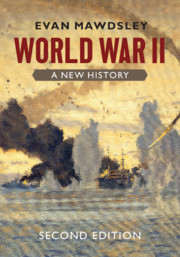Refine search
Actions for selected content:
15418 results in Military history
3 - The Roman Way of War 250 BC–AD 300
- from Part I - The Age of Massed Infantry
-
-
- Book:
- The Cambridge History of Warfare
- Published online:
- 31 October 2020
- Print publication:
- 04 June 2020, pp 47-60
-
- Chapter
- Export citation
18 - The New World Disorder 1991–2019
- from Part IV - The Age of Mechanized Warfare
-
-
- Book:
- The Cambridge History of Warfare
- Published online:
- 31 October 2020
- Print publication:
- 04 June 2020, pp 421-464
-
- Chapter
- Export citation
Preface
-
- Book:
- The Cambridge History of Warfare
- Published online:
- 31 October 2020
- Print publication:
- 04 June 2020, pp vii-viii
-
- Chapter
- Export citation
Epilogue: The Future of Western Warfare
-
-
- Book:
- The Cambridge History of Warfare
- Published online:
- 31 October 2020
- Print publication:
- 04 June 2020, pp 465-488
-
- Chapter
- Export citation
Copyright page
-
- Book:
- The Cambridge History of Warfare
- Published online:
- 31 October 2020
- Print publication:
- 04 June 2020, pp iv-iv
-
- Chapter
- Export citation
11 - Nations in Arms 1763–1815
- from Part III - The Age of Guns and Sails
-
-
- Book:
- The Cambridge History of Warfare
- Published online:
- 31 October 2020
- Print publication:
- 04 June 2020, pp 189-218
-
- Chapter
- Export citation
17 - The Post-War World 1945–1991
- from Part IV - The Age of Mechanized Warfare
-
-
- Book:
- The Cambridge History of Warfare
- Published online:
- 31 October 2020
- Print publication:
- 04 June 2020, pp 387-420
-
- Chapter
- Export citation
6 - The Gunpowder Revolution 1300–1500
- from Part II - The Age of Stone Fortifications
-
-
- Book:
- The Cambridge History of Warfare
- Published online:
- 31 October 2020
- Print publication:
- 04 June 2020, pp 101-114
-
- Chapter
- Export citation
10 - States in Conflict 1661–1763
- from Part III - The Age of Guns and Sails
-
-
- Book:
- The Cambridge History of Warfare
- Published online:
- 31 October 2020
- Print publication:
- 04 June 2020, pp 167-188
-
- Chapter
- Export citation
1 - Genesis of the Infantry 600–350 BC
- from Part I - The Age of Massed Infantry
-
-
- Book:
- The Cambridge History of Warfare
- Published online:
- 31 October 2020
- Print publication:
- 04 June 2020, pp 15-30
-
- Chapter
- Export citation

World War II
- A New History
-
- Published online:
- 18 May 2020
- Print publication:
- 30 April 2020
-
- Textbook
- Export citation
Epilogue: The Demilitarization of Chinese Socialism
-
- Book:
- Mao's Third Front
- Published online:
- 24 April 2020
- Print publication:
- 14 May 2020, pp 227-236
-
- Chapter
- Export citation
1 - The Coming of the Third Front Campaign
-
- Book:
- Mao's Third Front
- Published online:
- 24 April 2020
- Print publication:
- 14 May 2020, pp 40-78
-
- Chapter
- Export citation
Acknowledgements
-
- Book:
- Mao's Third Front
- Published online:
- 24 April 2020
- Print publication:
- 14 May 2020, pp x-xii
-
- Chapter
- Export citation
Contents
-
- Book:
- Mao's Third Front
- Published online:
- 24 April 2020
- Print publication:
- 14 May 2020, pp v-v
-
- Chapter
- Export citation
3 - Concentrating Forces to Wage Wars of Annihilation
-
- Book:
- Mao's Third Front
- Published online:
- 24 April 2020
- Print publication:
- 14 May 2020, pp 122-164
-
- Chapter
- Export citation
Index
-
- Book:
- Mao's Third Front
- Published online:
- 24 April 2020
- Print publication:
- 14 May 2020, pp 272-282
-
- Chapter
- Export citation
Copyright page
-
- Book:
- Mao's Third Front
- Published online:
- 24 April 2020
- Print publication:
- 14 May 2020, pp iv-iv
-
- Chapter
- Export citation
Abbreviations
-
- Book:
- Mao's Third Front
- Published online:
- 24 April 2020
- Print publication:
- 14 May 2020, pp ix-ix
-
- Chapter
- Export citation
Bibliography
-
- Book:
- Mao's Third Front
- Published online:
- 24 April 2020
- Print publication:
- 14 May 2020, pp 245-271
-
- Chapter
- Export citation
